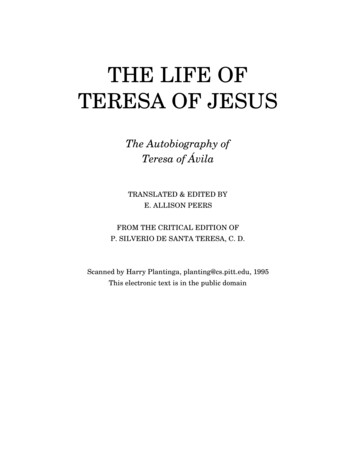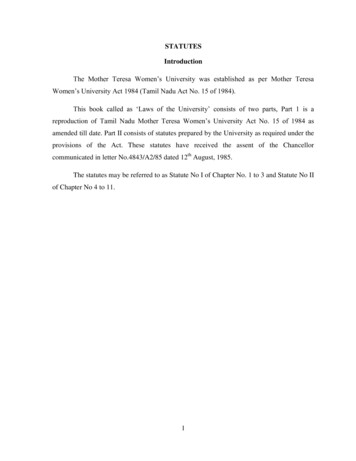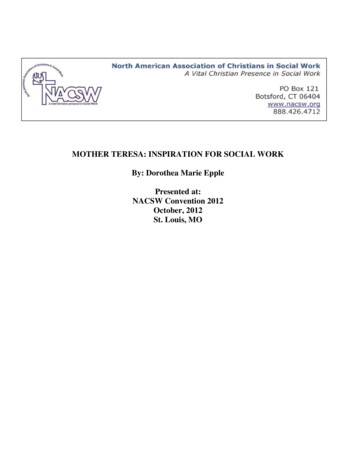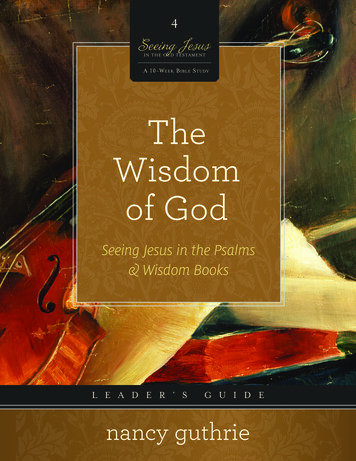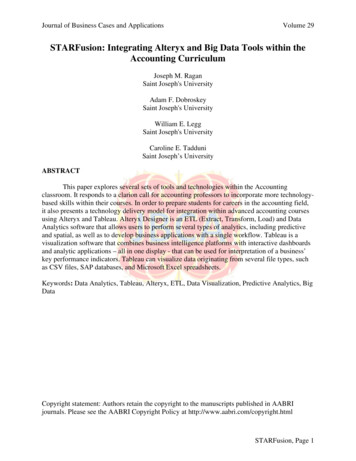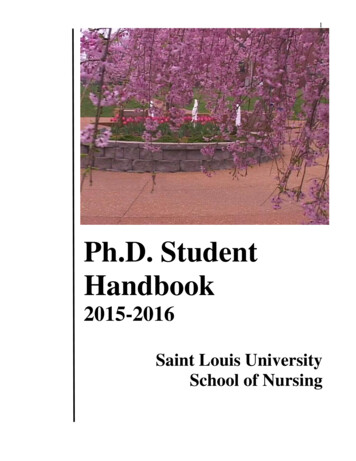
Transcription
Contemplations & Living WisdomSaintTeresaofAvilaPassionateMysticMirabai StarrForeword by Caroline MyssBOULDER, COLORADO
ContentsOpening Prayer . . . viiForeword . . . ixIntroduction . . . xiiiCHAPTER 1Saint Teresa Unfolding . . . 1CHAPTER 2The Journey Within . . . 23CHAPTER 3A Single Flame . . . 45CHAPTER 4Sacred Friendship . . . 57CHAPTER 5The Prayer of Pain . . . 73CHAPTER 6Visions . . . 85Closing Prayer . . . 101About the Author . . . 105Sources . . . 107Credits . . . 111v
1Saint Teresa UnfoldingTransfigured by TearsLa Madre Teresa was rushing through the conventon some errand she could scarcely remember. She wasdistracted. There was a festival coming up, and since shewas prioress, she found herself, as usual, responsible forall the administrative details. Oh, that was it: the statue!The Poor Clares had loaned the Sisters of Saint Joseph’sa statue of Christ scourged at the pillar. Teresa needed tofind it and get it properly situated in the chapel.There it was—propped against a wall in the hallwaylike a common broom. Irritated, Teresa bent to pick it up.As she was leaning down toward the image of her Lord,he was suddenly leaning upward toward her.She stepped back, struck by the animation in hisexpression. His face was simultaneously wrenched bythe anguish of injustice and radiant with compassion for1
all living beings. The sweet suffering mouth! The rivuletsof blood! The love-longing in his eyes!Before she realized what had struck her, Teresa wasprostrate on the floor. “Oh, my Beloved,” she moaned. “Iam so sorry I have neglected you all these years. Lookat all you have endured for love of me, and I have neverreally loved you back.”She began to cry. “I do love you, my Lord! I willnever stop loving you. Please give me the strength andcourage to devote myself entirely to you.” The tears camein a mighty flood. She wept and gasped for air, and weptagain. She, who, for almost twenty years, had watchedthe other nuns with a mixture of envy and contempt asthey wept their way through their prayers while she wasincapable of squeezing out a single holy tear, now couldnot stop crying.“I will not move from this spot until you give me whatI want, Lord!” she demanded. The first of many demands.The first of many direct encounters with her difficult,devoted, long-suffering, good-humored Beloved.When at last she rose from her immovable spot,her own face was radiant with satisfaction. The hollowvessel her tears had carved in her heart was overflowing with love. More abundant love than she couldhave asked for, more enlivening and intoxicating andunshakable love.2 Saint Teresa of Avila
As the floodgates flew open, the visions, too, beganpouring through. And the divine voices. And theunrelenting, inconvenient, all-too-public raptures andecstasies. These mystical states did not go unnoticedby the Spanish Inquisition, and, although Teresa wasrepeatedly denounced, they never managed to prove hera heretic. In fact, almost every man who investigated theunconventional nun ended up falling at her feet.BA Wild ChildSaint Teresa of Avila was born Teresa de Cepeda yAhumada in 1515, during the height of the Inquisitionin Spain. She was the granddaughter of a converso, a Jewforced to convert to Christianity on pain of death. Thesethinly disguised Jewish roots, combined with the factthat she was a woman, made Teresa an unlikely candidate for a saint, let alone a reformer of an entire branchof the Catholic Church.Yet Saint Teresa was the architect of the Discalced,or Barefoot Carmelite order, and she dedicated her lifeto reconnecting this ancient sect with its contemplativeorigins of solitude, silence, and interior prayer. Even inher own lifetime, Teresa was revered as la santa, whichSaint Teresa Unfolding 3
she found endlessly amusing, given her radically humbleopinion of herself as an incorrigible “sinner.”Teresa of Avila was infused with a quiet flame thatset all boundaries on fire and ignited every heart shetouched. She was physically beautiful—voluptuous andsultry—with luxurious dark hair and sparkling blackeyes. She was a musician and a dancer, a poet and atheologian. She was such a prolific writer that it earnedher the distinction of first female “Doctor of the Church,”meaning her theological contributions had permanentimpact on the development of Roman Catholic thought.Teresa’s exceptional intellect was balanced by herpassionate emotions. She was gregarious and impatient,alternately inclined toward radical solitude and intimateconnection with community.As with most of us on a spiritual path, Teresa’sdevotional inclinations began showing up at an early age.She had learned to read by the time she was five yearsold. When she read in Lives of the Saints about certainwomen martyrs whose sacrifices bought them a ticketstraight to heaven, she decided to enlist her brotherRodrigo to join her on a quest: they would travel tothe country of the Moors and beg them to cut off theirheads for God. But, to Teresa’s dismay, an uncle spottedthe children just outside the gates of Avila and broughtthem home.4 Saint Teresa of Avila
Whenever the bossy Teresa played with other littlegirls, she made everybody pretend they were nuns ina convent. She built hermitages out of stones in theorchard behind her parents’ house, determined tolive alone there with her God. She would latch on tocertain religious concepts and repeat them like a mantra,catapulting herself into a mystical trance. “Forever,” shewould chant. “Forever, forever, forever . . .”Teresa’s mother was beautiful, too, and wise. She instilled a deep love of books in her small daughter—a lovethat would not only define the rest of Teresa’s life, butactually save it. While this passion for the written wordfirst manifested as “a raging addiction to romance novels,”Teresa eventually came to relate to books as authentictools for spiritual transformation and claimed that shenever went to prayer without a book close beside her.Even if she didn’t open it, she said, knowing it was therewas enough to bring her into a state of focused spiritualrecollection. When the Inquisition banned books oncontemplative practice written in the vernacular, she feltas if her best friends had been condemned to death.Teresa’s mother, Beatriz, was the second wife of herfather, Alonso, and the younger cousin of his first wife,who had died of the plague. Beatriz was barely thirteenwhen they married. By fourteen, she had given birthto her first son and was raising Alonso’s two daughtersSaint Teresa Unfolding 5
from his first marriage as her own. Beatriz died inchildbirth with her ninth baby, at the age of thirty-three.Teresa was thirteen. Bereft and unfettered, Teresa spunout of control. All her early religious impulses faded intothe dazzling allure of teenage rebellion.Teresa liked to be liked. Ultimately, this psychologicalfact was to serve as both the single greatest obstacle andthe most effective political weapon of her life. No oneknows for sure what particular escapade finally resultedin Teresa’s being carted off to the convent at age sixteen.Was she discovered walking unchaperoned in the gardenwith a boy? Or did she lose her virginity?What we do know is that Teresa’s father so unconditionally adored her that, in his mind, she was incapableof doing anything seriously unscrupulous. He concludedthat a year in an Augustinian convent would be justthe right amount of time for his lively daughter to calmdown. Meanwhile, she would receive a little education(too much learning was considered unseemly in a girl),and the fire of scandal in the community would havetime to die down and blow away.But Teresa’s social nature followed her to the conventof the Incarnation. There she convinced the nuns, as shehad persuaded her father and her brothers all her life,that she was eminently trustworthy and deserving of farmore freedom than they granted the other girls. Even as6 Saint Teresa of Avila
Teresa habitually bristled against authority and the confines of any imposed structure, she began to enjoy thelong hours of prayer, during which she would slip intoa state of deep quietude and forget all about the earthlyattachments that had plagued her. She still didn’t wantto be a nun, but she wanted to want to be a nun, and shebegged the older sisters to pray on her behalf that herreligious vocation would become clear.Teresa found herself in a bind. The prospect of marriage repulsed her. Having witnessed the ravages sufferedby her own mother, Teresa, who freely admitted shecouldn’t bear the thought of any man telling her whatto do, could not imagine taking the path of matrimony.Yet her draw to monastic life did not arise out of any“holy inclinations,” but rather from a sense of impendingdanger. She was afraid that her tendency to lose herselfin the world would eventually mean forfeiting heaven.Added to her own inner ambiguity was the problemof her father: he did not want Teresa to become a nun.He had worked hard, as his father had before him, toclimb to the top rungs of the social ladder and distancehimself from his converso origins. Alonso’s father, JuanSanchez, had succeeded in acquiring the title of hidalgo,an honor traditionally bestowed only on those of pureChristian blood, but one that, in this corrupt age, couldbe purchased at a price. Juan had passed the rank ofSaint Teresa Unfolding 7
knighthood on to his son. Alonso had plans for his favorite daughter to marry well and uphold the family honor.Alonso was nine years old when his father was denounced as Crypto-Jew and accused of secretly practicinghis ancestral religion. In punishment, and to serve as anexample, the family had been draped in bright yellow costumes emblazoned with snakes and flaming crosses, andmarched through the streets of Toledo for seven consecutive Fridays. They were forced to kneel at every chapeland shrine along the way, while the citizens spat at them,threw rocks, and hurled verbal abuses. The humiliation ofthis early experience caused Alonso to hold on as tightlyas he possibly could to the aristocratic standing he hadwon. But his daughter would not cooperate.Like Clare of Assisi before her, Teresa slipped awayin the middle of the night and, against the wishesof her beloved father, returned to the convent of theIncarnation in secrecy. Defying the person she lovedmost in the world wrenched her heart so severely thatshe felt as if all her “bones were being dislocated.” But because she feared for her soul more than she dreaded herfather’s disapproval, she endured the agony of forsakinghim. After warning that he would die before granting hispermission, Alonso eventually relented and gave Teresahis blessing, as well as a generous dowry. She professedvows and was given the name Teresa of Jesus.8 Saint Teresa of Avila
Convents at that time were overcrowded with girlswhose families didn’t know what else to do with them.Women from wealthy homes brought their servants withthem and lived more like nobility than nuns. Monasticlife had little to do with the practice of prayer. Becausefood was scarce, visitors were encouraged, since theyalmost always brought treats for the convent kitchen. Onweekends, the parlor was filled with townspeople whowere supposedly there to discuss the state of their soulswith the sisters, but these spiritual counseling sessionseasily degenerated into an excuse for flirtation and gossip.Teresa was the center of attention. She was attractive,witty, and vivacious. She was also brilliant, and she tempered her frivolous impulses with a genuine insightfulness about human psychology and its connection to thespiritual path. Men of all ages found her irresistible andbegan to clamor for time with the remarkable young nun.In spite of herself, Teresa responded to their affectionsby falling in love again and again, living for the dayswhen she got to see her devotees and speak with them.Teresa’s confessors considered this pastime to beharmless, but Teresa tormented herself with harshjudgments about her obsession with these relationshipsand the ease with which she manipulated everyone intoliking her. The tension this created inside her finallymade Teresa sick. She began developing mysteriousSaint Teresa Unfolding 9
fevers and suffering headaches and fainting spells. Shebecame so ill that her father had to come take her home.The physicians of Avila were mystified. They couldnot come up with a diagnosis and failed to prescribea cure. At last, they gave up on Teresa altogether.Desperate, Alonso set out to the village where his oldestdaughter, Maria, lived with her husband. They werehoping to find a certain curandera (a medicine woman)who was said to have miraculous healing powers. Alongthe way, they spent a couple of nights with Alonso’snewly widowed brother, Pedro.Moved by a deep sense of sanctity underlying hisniece’s poor health, Uncle Pedro asked Teresa to readaloud to him from a book he had recently acquired onthe practice of contemplative prayer. This book had hadsuch a profound effect on Pedro that he had begun tocultivate a serious discipline of silent meditation. His intuition was that Teresa might find all her troubles fallingaway if she followed this simple yet powerful method.Teresa was captivated by these teachings, and theyended up forming the foundation of spiritual practice forthe rest of her life. The minute she turned her attentionwithin, she found herself in intimate friendship withthe Divine. She savored these moments, amazed by howeffortlessly she slipped into the presence of her divineBeloved and how graciously he received her.10 Saint Teresa of Avila
Teresa’s mother was beautiful, too, and wise. She in-stilled a deep love of books in her small daughter—a love that would not only define the rest of Teresa’s life, but actually save it. While this passion for the written word first manifested as “a raging addiction to romance novels,”
